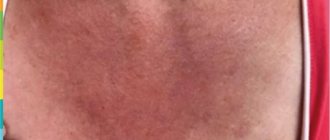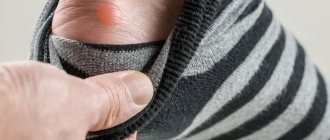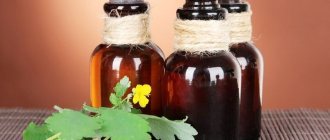Classification of papillomas
Based on their appearance, papillomas are divided into the following types:
- pointed;
- flat;
- threadlike;
- simple;
- plantar.
Depending on the type of virus and the characteristics of its effect on the human body, the following types of papillomas are distinguished:
- non-oncogenic - do not degenerate into cancerous tumors, do not pose a health hazard, and are a purely cosmetic defect;
- oncogenic low risk - the probability of papilloma degenerating into cancer exists, but it is small, a mutation can only occur as a result of a strong carcinogenic effect on the body;
- high-risk oncogenic - such papillomas almost always degenerate into malignant neoplasms over time.
When the first symptoms of HPV appear, you must consult a doctor and undergo an examination to find out the type of virus. Early diagnosis of oncogenic forms can save a person’s life.
Universal recipe: potato juice
Regardless of which area is affected by papillomas (neck, intimate areas of the body, face), you can use a recipe based on the use of fresh potato juice. It is taken orally half a glass twice a day before meals. The course of treatment lasts 2 months. The therapy also helps with stomach ulcers and liver diseases. However, in case of diabetes mellitus and low stomach acidity, you should avoid this recipe.
Causes of papillomas
The cause of the disease is HPV (human papillomavirus) . When it comes into contact with the skin, this virus begins to multiply in the squamous epithelium. As long as a person is healthy, the virus lives quietly in the body and does not cause any problems.
But as soon as the immune defense weakens, the virus immediately becomes active and begins to change the nuclei of squamous epithelial cells. As a result, abnormal cells begin to appear, which actively grow and cause papilloma to appear on the skin.
The main routes of HPV infection are:
- Unprotected sexual contact .
The genital mucosa is very susceptible to the papilloma virus. If one of the partners has papillomas on the genitals, then the probability of infecting the second partner is almost 100%. Using condoms reduces the likelihood of infection, but if the papillomas are located in unprotected places (for example, in the perineum), then infection will still occur. It should be remembered that you can become infected with HPV not only during sex, but also through kissing. - Self-infection . It can occur during hair removal or shaving, as well as when rubbing an existing papilloma with clothing. As a result, several more new papillomas may appear on the skin.
- Infection of a child by the mother during childbirth . If the mother has papillomas in the genitals, the child can catch the HPV virus during childbirth. This form of the disease is very difficult to treat.
- Infection in public places . You can become infected with HPV by holding onto dirty handrails in public transport, as well as in a bathhouse, sauna, swimming pool, or locker room at the gym. A virus left in these places by a sick person causes infection if it enters the body through damaged skin.
- Infection through household items used by the patient . Most often, infection occurs when using other people's epilators, towels, razors, and washcloths.
Papillomas in the stomach: effective treatment with folk remedies
If papillomas form in the stomach, this is a more dangerous situation that requires seeking medical help. In addition to medications, you should also use home recipes that have a good effect not only on the stomach, but also on the general condition of the body. Quail eggs are the most readily available. They are taken raw daily (mix 2-3 eggs and add a little salt). Another option is to grind the shells to a fine powder and take a third of a teaspoon orally. Drink with two glasses of water. In both cases, therapy is repeated twice a day until complete recovery.
And another option is to use maclure fruits (the so-called Adam's apple). Half a kilogram of finely chopped fruit is poured with half a liter of vodka, corked and infused in a dark place for a month. Take 3 drops orally before each meal. The first week the course consists of 2 procedures per day, and the second - 3 times a day until complete recovery.
And the last recommendation. It is important not only to know how to remove papillomas, but also to use folk remedies to strengthen the immune system. As a rule, such formations develop in a weakened body, so if you take vitamin C at the same time, this will significantly speed up recovery.
Back Next
Symptoms of papillomas
Papillomas look like skin growths that are soft to the touch. They have a flat base or stand on a thin stem. In the early stages of development, before they come out, papillomas can cause slight tingling and burning of the skin.
Then a small lump appears at this place, which eventually turns into a papilloma. The color of the new growths is usually flesh-colored, yellowish or grayish. Papillomas are more likely to form in older people.
Unlike warts, papillomas appear on closed areas of the body - in the groin, in the armpits, on the inner thighs, under the mammary glands. Papillomas appear when the immune system is weakened, after suffering from somatic and infectious diseases. A single papilloma can cause the appearance of other neoplasms, and then they talk about the development of a disease such as papillomatosis.
Diagnosis of papillomas
For an experienced doctor, making a diagnosis does not pose any particular difficulties . It detects papillomas during an external examination of the patient. To determine the type of virus that caused the appearance of the neoplasm and assess the likelihood of papilloma degenerating from a benign to a malignant state, the following studies are carried out:
- PCR – HPV DNA is detected and the type of virus is determined; this study is carried out if papilloma has already appeared on the patient’s skin;
- colposcopy - using this technique, they study the mucous membrane of the cervix in women using a special device (colposcope) and detect papillomas there;
- biopsy – performed to exclude cancer.
CITROSEPT drops for oral and external use, dropper bottle 10ml
Locally: Apply Citrosept to washed skin. Start taking it with the minimum indicated concentrations (especially in children), but if the skin and mucous membranes are not too sensitive or there is no effect, the concentration can be gradually increased. For dilutions, use boiled water and always mix the solution thoroughly. Monitor the body's reaction and, depending on it, increase or decrease the dose. Inside: only diluted! Citrosept should be taken in doses of 10-25 drops (depending on body weight and severity of the disease) 2-3 times a day, diluted with 100-200 ml of any liquid, mixed thoroughly. The liquid may be warm, but not hot. You can use boiled water. For chronic diseases, the course is from 2 to 3 months or until symptoms disappear. Reception can be continued for up to 4-6 months. A volume of 50 ml is enough for an average of 1.5 months. For prevention: adults - 5-10 drops 2 times a day. In the initial stages of a cold, flu or poisoning, it is advisable to take “loading doses” of 20-70 drops 2-3 times a day for a course of 2-3 days. If the Herxheimer reaction is too intense, the dose should be reduced; for children - 1 drop per 1 kg of body weight per day and divide the total number of drops into 3 doses. Citrosept can be taken regardless of meals, but not less than 30 minutes before, and in case of high acidity, stomach ulcers, gastritis or heartburn - only immediately before meals. Those taking the extract for the first time should start with 2-3 drops 2-3 times a day and increase the total amount by 2-3 drops daily for about 2 weeks. Fungi of the skin, mucous membranes and nails: Candidiasis: systemic, oral cavity, skin, mucous membranes, diaper candidiasis, onychomycosis, dermatomycosis, vaginitis. Oral administration + local application (rinses, applications, irrigation of mucous membranes). Diaper candidiasis: Local use only: 4 drops of Citrosept per 20 ml of vegetable oil - apply the solution 3 times a day. 5-10 days. Dermatoses: atopic dermatitis, psoriasis, eczema, microsporia, acne, herpes simplex, lichen planus, genital infections in women and men. Inside + outside. Candillomas, papillomas, warts on the skin: internally + externally, 1-2 drops of the drug without dilution, gently onto the affected area 2-3 times a day. Mixed fungal-bacterial lesions of the skin and nail plates: internally + externally. Respiratory tract: bronchitis, sinusitis, influenza and other acute respiratory viral infections, bronchial asthma, tonsillitis, parainfluenza: oral administration + gargling + nasal rinsing + aerosol therapy. Seborrhea of the scalp: external use. Dentistry: stomatitis, gingivitis, periodontal disease, oral hygiene and for freshening breath: oral administration + rinsing + disinfection of toothbrushes. Gastroenterology: dysbiosis, liver failure, complex therapy of hepatitis, including viral hepatitis, gastritis - oral administration. Acute intoxication of various etiologies, including alcohol, immunodeficiency, antibiotics, chemotherapy, radiation: oral administration. Cleansing and weight loss courses, including cellulite, parasites: oral administration. Itching and swelling due to insect bites, including ticks: 1 drop externally, 4-5 times a day. Lyme disease (Borreliosis): orally. Wounds, cuts, burns: rinse externally with a solution (10-20 drops per 100 ml of water), 4-5 times a day. Atherosclerosis: oral administration. Varicose veins and trophic ulcers: externally - 30 drops per 30 ml of water. Soak gauze and apply to the sore spot (if there are no open wounds). Change dressings 2-3 times a day. Obstetrics and gynecology: female fungal and bacterial infections - oral administration + irrigation of mucous membranes. Nail fungus: It is recommended to trim your nails as short as possible every 2 days. Apply 1-2 drops of Citrosept in the form of an application on the nails and the area around the nails 2-3 times a day. Continue the course until an uninfected nail grows out (from 2 to 8 months). It is necessary to take Citrosept orally during the course and 1 month after the symptoms disappear. Dermatoses: start with a concentration (Citrosept with water) 1:4, then 1:3, 1:2 and 1:1, 3 times a day. The course until the effect is obtained is 7-14 days. Inside according to the diagram. For ACNE, use only with water. Herpes: children from 1:4 to 1:2; adults 1:1 or without dilution. 2-3 times a day, gently on the areas of rash for up to 5 days or until symptoms disappear, do not allow the undiluted extract to come into contact with the skin or nearby mucous membranes. The sooner you start taking Citrosept, the faster the effect is achieved. In case of purulent inflammation or eczema, first dry the affected area. Seborrhea (dandruff): add 7-15 drops to a portion of shampoo, wash hair and rub into skin for about 2 minutes, then rinse well with water. Take every 2-3 days in a course of 7-12 doses. Continue for 2 weeks after symptoms disappear. Avoid contact with eyes. Gargling: 3-12 drops in 200 ml of warm water. Gargle with this solution 5-7 times a day. After rinsing, the solution can be swallowed. Rinse the nose: 2-4 drops (children: 1-3 drops) of the drug per 100 ml of cold boiled water, rinse 2-3 times a day, tilt your head back and shake it in different directions, clean your nose well. Irrigation of mucous membranes during STDs: for women - rinse with a solution of 10-15 drops (initially 10) per 1 liter of water 2 times a day; for men - carefully apply the solution (1 tablespoon of vegetable oil and 1-4 drops of the drug) to the affected areas 3 times a day for a few minutes, rinse well each time. Aerosol therapy: 2-3 drops of Citrosept in 3-4 ml of saline through a nebulizer. Mouth rinse: 4-11 drops (1 drop for children) per 200 ml of warm water, rinse or wipe with gauze at least 3 times a day. Rinsing disinfects the mouth and freshens breath. For prevention, n.p. After visiting a bathhouse or swimming pool, you can apply a solution of 10-20 drops per glass of water to the skin.
Treatment of papillomas
There is currently no single international standard for the treatment of papillomas. The main methods recognized throughout the world are:
- treatment with cytostatics (antitumor drugs);
- electrocoagulation;
- cryodestruction (removal of papillomas using abnormally low temperatures);
- laser removal of papillomas;
- surgical excision.
Skin tumors are usually removed surgically (laser, cryodestruction). To prevent the appearance of new papillomas, the patient is prescribed treatment aimed at strengthening the body's immune defense.
Plantar papillomas are removed using diathermocoagulation and cryodestruction. If the patient has flat papillomas, they are removed using cryotherapy with the simultaneous administration of immunostimulants.
Threaded papillomas are removed using diathermocoagulation, warty ones - using cryotherapy or diathermocoagulation with subsequent restoration of immunity.
Genital warts are removed using laser, cryotherapy, and diathermocoagulation. Genital papillomas are destroyed with a solution of trichloroacetic acid, podophyllin. It should be remembered that treatment of genital papillomas can be difficult in the presence of concomitant diseases (herpes, bacterial vaginosis, chlamydia and a number of others). In this case, treatment of these pathologies is carried out in parallel. Laryngeal papillomatosis is treated surgically.
Contraindications to the use of herbs in the treatment of papillomas
Despite the naturalness of such products, it is not recommended to use them without medical supervision.
Pregnant women should be very careful when using herbal medicine , as it can harm the baby and mother by provoking an allergic reaction.
When breastfeeding, it is also advisable to postpone treatment of the papilloma virus with herbs, since many of them can spoil the taste of milk, making it more bitter or sweet. In turn, this may lead to the child abandoning him.
It is not advisable to take the medication orally on an empty stomach , otherwise mild nausea, abdominal pain and even bloating may occur. This is why you need to at least drink some water first.
Other contraindications to the use of herbs for the papilloma virus include:
- Gastritis . This is a disease in which the walls of the stomach are affected, they become inflamed and red. Because of this, if you ingest various herbs with a strong taste and aggressive substances in their composition, you can provoke pain and nausea.
- Colitis . This disease refers to inflammation of the intestinal walls, which can be observed both along its entire length and only in certain areas. Ingestion of remedies, depending on what kind of herb for papillomas we are talking about, can cause attacks of colic and pain, and lead to exacerbation of colitis.
- Pancreatitis . Simply put, it is an inflammation of the pancreas. With this disease, it increases in size completely or in certain areas. Due to the accumulation of enzymes secreted by it inside, this organ is destroyed. Taking tinctures, decoctions, infusions can enhance the production of these substances and aggravate the patient’s situation, depending on what herb for papilloma they are prepared with.
- Diseases of the gallbladder and liver . For such problems, it is not recommended to use aloe extract and anything prepared on its basis. It accelerates the secretion of bile, which, accumulating here, provokes attacks of colic, yellowing of the sclera of the eyes and nausea. The same applies to thyme, nettle, and wormwood because of their bitterness.
- Kidney disease . First of all, people who have been diagnosed with nephritis should use herbs carefully. They should not use nettle and horsetail, since they irritate the tissues of this organ and create optimal conditions for the occurrence of painful sensations.
Important! Those who do not know what herbs to take for papillomas should be warned - you should not use more than 4-6 types in one product, this can interfere with its absorption and slow down the healing process.
- See also contraindications to the use of banana against warts and papillomas
Folk remedies for papillomas
Traditional medicine methods, with the right approach, can overcome many ailments . Medicinal products created according to grandmother’s recipes have numerous pharmacological advantages. They are not only effective, but also safe, as they do not give side effects, strengthen the immune system and help the body fight illnesses. They do not contain preservatives or artificial flavors found in chemical medications. They are made one hundred percent from natural raw materials. Traditional medicine is also widely used in the treatment of skin lesions, including papillomas.
Removing papillomas is a rather painful and unpleasant procedure, so many people solve this problem on their own using gentle methods . For treatment at home, both pharmaceutical drugs and alternative medicine methods are used. Folk remedies used internally are aimed at strengthening the immune system and preventing relapses. External preparations remove the external defect, causing the growths to dry out and then fall off.
Before starting treatment, it is necessary to make sure that the neoplasm cannot degenerate into a malignant tumor. Suspicion of oncology may be caused by:
- rapid growth of papilloma;
- painful sensations;
- formation of ulcers and discharge in problem areas.
Such growths cannot be removed without prior examination and consultation with a doctor. For papillomas on the face, neck and other areas with thin skin, recipes are selected especially carefully and carefully.
Folk remedies that boost immunity
Weakened immunity is one of the reasons that provokes the appearance of papillomas on the human body . To get rid of them forever, you need to strengthen your immune system. The disappearance of papillomas is facilitated by herbal preparations and other means to enhance immunity:
- a collection of tricolor violet, wormwood, clover flowers, St. John's wort, plantain, dill seeds and calamus root;
- a collection of horsetail, nettle, plantain, lemon balm and dandelion root;
- tinctures of rosehip, echinacea;
- daily intake of 100-200 ml of potato juice (preferably red).
Treatment of papillomas with non-herbal folk methods
Traditional medicine often uses products that are found in every home for treatment. It is important to remember that not every product can be used to remove papillomas on the tongue, eyelids and other mucous membranes, as well as surfaces close to them.
Treatment of papillomas with egg
A popular way to get rid of growths is a regular chicken egg. For treatment you will need protein, which is applied to the affected areas. After drying, apply another layer of protein and leave for several hours. The procedure is repeated for several days until the papillomas are completely dry and disappear.
Castor oil for treating skin lesions
Growths that form on the neck and other areas of the skin can be cured with castor oil. Castor oil contains an acid that affects tumors. Castor oil is applied to papillomas, a patch is glued on or a bandage is applied. The procedure is carried out twice a day. To get rid of growths, it is repeated 6 times.
Getting rid of growths using laundry soap
One of the popular folk remedies for the treatment of skin diseases is laundry soap. For four days it is rubbed into problem areas. As a result, irritation appears on the skin, the growths dry out and fall off.
Methods of treatment using herbal remedies
To get rid of papillomas, both individual plants, their stems, flowers, buds, fruits and roots, and collections that include several ingredients are used. Can be used both internally and externally.
Treatment with celandine juice
Celandine juice contains acid that helps destroy and eliminate growths. For treatment, fresh squeezed juice, leaves and stems of the plant, as well as an infusion, which can be purchased at the pharmacy, are used. It is advisable to steam the skin before the procedure. To avoid acid getting into healthy areas, the epidermis around the papillomas is carefully lubricated with oil or rich cream. The juice of the plant is applied pointwise to each growth. The procedure is carried out once every two days for a week.
Recipes using garlic
Treatment with fresh juice squeezed from onions and garlic is painful, but effective. It is periodically applied with a pipette to each growth. Papillomas first dry out, then darken and fall off.
Finely chopped garlic is mixed with butter. The mixture is applied to problem areas and washed off after two hours. After several procedures, the growths dry out and fall off.
Human papillomavirus
Natalia
While searching for information on the Internet, I am very glad that I came across your site, and I really hope that you can help me. I am 42 years old, my height is 174 cm, my weight is 95 kg (I understand that I have a lot of excess weight and now I’m trying to lose weight, I just eliminated unhealthy foods, I’m afraid of sports because of the cyst). I am contacting you with gynecological problems. Every year I go to the gynecologist and have routine check-ups to monitor my health. My periods are always regular, not heavy, but painful (the reason for this was always said to be due to the curvature of the uterus), the cycle is 28-30 days, I have not given birth, and I have not taken any hormones. In 2022, there was an operation - hysteroresectoscopy of an endometrial polyp (histology result - glandular endometrial polyp). In June 2022, I also went to an appointment, had a smear - everything is fine, a smear for oncocytology - everything is also good, colcoscopy - everything is clean (I do it every year, because I monitor the cervix, once upon a time HPV was detected, but it doesn’t manifest itself in any way for me, and they simply told me to strengthen my immune system and monitor my cervix).
I also did an ultrasound of the pelvic organs (day 6 of the MC) - Uterus: the uterus is located correctly along the midline, spherical in shape. The boundaries are clear, the contours are even. The dimensions are not increased: length - 59 mm, pre-posterior - 49 mm, width - 51 mm, volume - 77 ml. The thickness of the walls of the uterus is symmetrical. The echogenicity of the myometrium is average. The echostructure of the myometrium is heterogeneous due to the presence of hypoechoic nodes with smooth, clear contours, ranging in size from 11*12 mm to 23*23 mm of a homogeneous solid structure, with peripheral blood flow along the central circulation. There are no formations in the uterine cavity, the uterine cavity is not dilated or deformed. The endometrium is 6 mm thick, corresponding to the 1st phase of MC. The border between the myometrium is preserved and not deformed. The basal layer is clear and smooth. Neck: dimensions: length - 35 mm, width - 37 mm, thickness - 31 mm. The echostructure is homogeneous, the echogenicity is average. The endocervix is up to 1.5 mm, the cervical canal is not dilated, no space-occupying lesions have been identified. Right ovary: determined in a typical location. The contours are smooth. Dimensions: 30*24*16 mm, Volume - 6.0, echostructure is not changed, echogenicity is average. The follicular apparatus differentiates, the follicles are located along the periphery of the ovary. The number of follicles in the section is up to 6, the diameter of the follicles is 6-8 mm, the dominant one is absent, no space-occupying formations are identified. Left ovary: determined in a typical location. The contours are smooth. Dimensions: 31*25*16 mm, volume - 6.4 ml, echostructure is not changed, echogenicity is average. The follicular apparatus differentiates, the follicles are located along the periphery of the ovary. The number of follicles in the section is up to 7, the diameter of the follicles is 6-8 mm, the dominant one is absent, no space-occupying formations are identified. Volumetric formations: in the structure of the ovary, a rounded hypoechoic formation with a thin capsule, with clear even contours, a homogeneous structure, dimensions 33*33 mm, avascular according to the color circulation is located. Free fluid in the retrouterine space is not detected.
Conclusion: Echosigns: Multiple interstitial uterine fibroids. Cysts (endometriotic?) of the left ovary.
These are the results I got, I knew about fibroids, at the age of 37 they found 1 small fibroid, and now there are already three of them, this is very sad, and I am very concerned about the appearance of a cyst. The doctor at the residential complex said to do an ultrasound in 2-3 months in another place, but for now just observe, and at that time I began to search on the Internet for how to treat with traditional methods, and found a recipe for ointment tampons (wax oil and yolk) from a healthy lifestyle magazine , there were a lot of good reviews and stories of healing, and I decided to try it, and also drank walnut tincture, but probably all this was in vain, I only harmed myself, because... in September there was a glitch, this had never happened before, in the middle of the cycle there was blood, like menstruation, but without pain, 2 days heavy with clots, and two days it just smeared. The next period came exactly 28 days after this bleeding.
I was able to do an ultrasound only in October (10/21/21) and here are the results of the ultrasound (day 5 of the MC): Uterus: normal shape, not enlarged: length - 65 mm, thickness - 100 mm, width - 79 mm. The position of the retroflexio, its contours are uneven, the echostructure of the myometrium is heterogeneous, due to visualization along the anterior wall of the avascular interstitial node, measuring 40*37 m, along the posterior wall of the avascular interstitial node with a diameter of up to 12 mm, in the area of the bottom of the avascular interstitial node, measuring 17*18 mm. M-echo 8 mm thick, proliferative type. The uterine cavity is not dilated or deformed. Cervix of the uterus: not enlarged: length - 39 mm, thickness - 29 mm, its contours are even. The echostructure is homogeneous. The cervical canal is not dilated. Endocervix 4.5 mm. Left ovary: located at the left corner of the uterus. Dimensions 50*37*51 mm. Volume - 11.3 cm3. The contours are smooth, the echostructure is small-follicular (follicles: 3-4 per section, maximum diameter up to 8 mm). In its structure, a cystic formation with a fine suspension, measuring 36*50 mm, with a moderate peripheral type of blood flow is located. Right ovary: located at the right corner of the uterus. Dimensions 31*18*20. Volume - 8.0 cm3. The contours are smooth, the echostructure is small-follicular (follicles: 1 per section, maximum diameter up to 5 mm). Fluid in the retrouterine space is not detected.
Conclusion: echoscopically - multinodular uterine fibroids. Left ovarian cyst (endometriotic? corpus luteum cyst?). Decreased follicular reserve of the right ovary. Now I don’t even know what to do, it turns out that the fibroids and the cyst have grown, and this is probably an endometrioid cyst, because... it did not disappear within 4 months (on the ultrasound they wrote that it could be a corpus luteum, but this is because I did not say before the ultrasound that I had a cyst), it is useless to go to the doctor in the LC, she suggests an operation, but I want to do without it. I studied herbal treatment on the Internet, because... I really respect herbal medicine, but I don’t know how to do it correctly and what herbs to take, I realized that the red brush and boron uterus help, but you need to know how to take them correctly and probably some other preparations are needed. I am very glad that I came across you, you have already helped many people, and I really hope that you will help me too. I am also very worried that the cyst may burst. Tell me, please, can it really burst? Is it possible to treat cysts and fibroids with herbs in this case? I am very, very afraid of the operation, and I heard that after it the cysts can grow again, I am looking forward to your answer with hope, and I apologize for such a long message. I would also like to know how I can buy herbs in your store, there is none in my city (Nizhny Novgorod), and I can’t go to the online store, for some reason it doesn’t open?
Prevention of papillomas
The main methods of preventing the disease are:
- refusal of promiscuous sexual relations;
- use of barrier contraception during sexual intercourse;
- compliance with hygiene rules;
- refusal to use other people's household items;
- compliance with safety rules when visiting public swimming pools, saunas, baths;
- hardening the body, strengthening the immune defense;
- proper nutrition - avoiding fatty, fried, spicy, smoked, canned foods, introducing fresh fruits and vegetables into the diet;
- giving up a sedentary lifestyle;
- timely treatment of infectious and somatic diseases that can lead to the appearance of papillomas;
- regular sanitation of foci of chronic infection that weaken the body’s immune defense;
- wearing comfortable clothes made from natural fabrics;
- Regular examination by an immunologist or gynecologist (for women).
Where can I buy
The online store “Russian Roots” offers ready-made potions, mixtures, ointments and other products, as well as ingredients for their preparation. Products can be ordered by phone and on the website or purchased in herbal pharmacies in Moscow. For residents of the capital and Moscow region, orders are delivered by courier. To other regions the goods are delivered by mail. Call and order high-quality, environmentally friendly products from the Russian Roots online store!
Attention! All materials published on our website are protected by copyright. When re-publishing, attribution and a link to the original source are required.











